Invented by Masamune Kaji, Michael John Slipy, Shigeru Natsume, Magic Leap Inc
IPD refers to the distance between a person’s pupils, and it plays a crucial role in creating a realistic and immersive VR/AR experience. Everyone’s IPD is unique, and having a headset that can be adjusted to match an individual’s IPD is essential for optimal visual clarity and comfort.
In the early days of VR/AR technology, many headsets had fixed IPD settings, which meant that users with different IPDs had to compromise on the quality of their experience. This led to discomfort, eye strain, and a lack of immersion, which hindered the widespread adoption of VR/AR technology.
However, with advancements in technology and growing consumer demand, manufacturers have started to prioritize adjustable IPD features in their headsets. This has opened up new opportunities for a more inclusive and personalized VR/AR experience.
One of the key benefits of adjustable IPD is improved visual clarity. When the IPD is correctly aligned with an individual’s eyes, the virtual world appears more realistic and lifelike. Users can perceive depth and scale accurately, enhancing their immersion and overall enjoyment of the experience.
Comfort is another crucial factor that adjustable IPD addresses. When the IPD is not properly aligned, users may experience eye strain, headaches, and discomfort. By allowing users to adjust the IPD, headsets can be customized to fit each individual’s unique facial structure, ensuring a comfortable and enjoyable experience even during extended use.
The market for VR/AR headsets with adjustable IPD is not limited to gaming and entertainment. Various industries, including healthcare, education, and manufacturing, are recognizing the potential of VR/AR technology for training, simulation, and remote collaboration. In these applications, having headsets with adjustable IPD becomes even more critical as it enables users to have a more accurate and immersive experience, leading to better learning outcomes and increased productivity.
As the market for VR/AR headsets with adjustable IPD continues to grow, manufacturers are investing in research and development to improve the technology further. They are exploring innovative solutions such as eye-tracking technology, which can automatically adjust the IPD based on the user’s eye movements, providing a seamless and personalized experience.
Additionally, advancements in optics and display technologies are also contributing to the improvement of adjustable IPD headsets. Higher resolution displays, wider field of view, and better lens designs are being integrated into these headsets, further enhancing the visual quality and comfort.
In conclusion, the market for VR/AR headsets with adjustable IPD is witnessing significant growth due to the increasing demand for personalized and comfortable experiences in the virtual world. Adjustable IPD not only improves visual clarity but also enhances comfort, making the overall VR/AR experience more immersive and enjoyable. With the potential applications of VR/AR technology expanding beyond gaming and entertainment, the demand for headsets with adjustable IPD is expected to continue to rise. Manufacturers are investing in research and development to further improve the technology, ensuring a more inclusive and personalized VR/AR experience for all users.
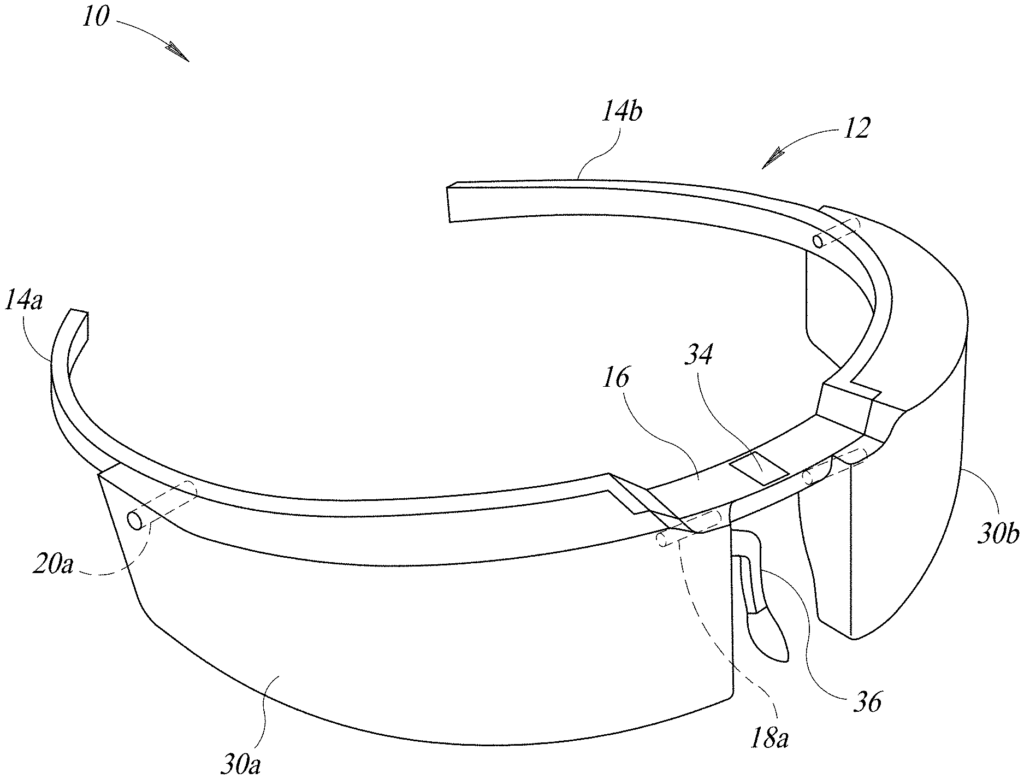
The Magic Leap Inc invention works as follows
A virtual reality or augmented-reality headset is provided with a frame, two virtual reality or augmented-reality eyepieces and an interpupillary adjustment mechanism. The frame has opposing arm member and a bridge located between the opposing arms. The adjustment mechanism can be coupled with the virtual or enhanced reality eyepieces, and is able to move them simultaneously to adjust the interpupillary spacing of the eyepieces.
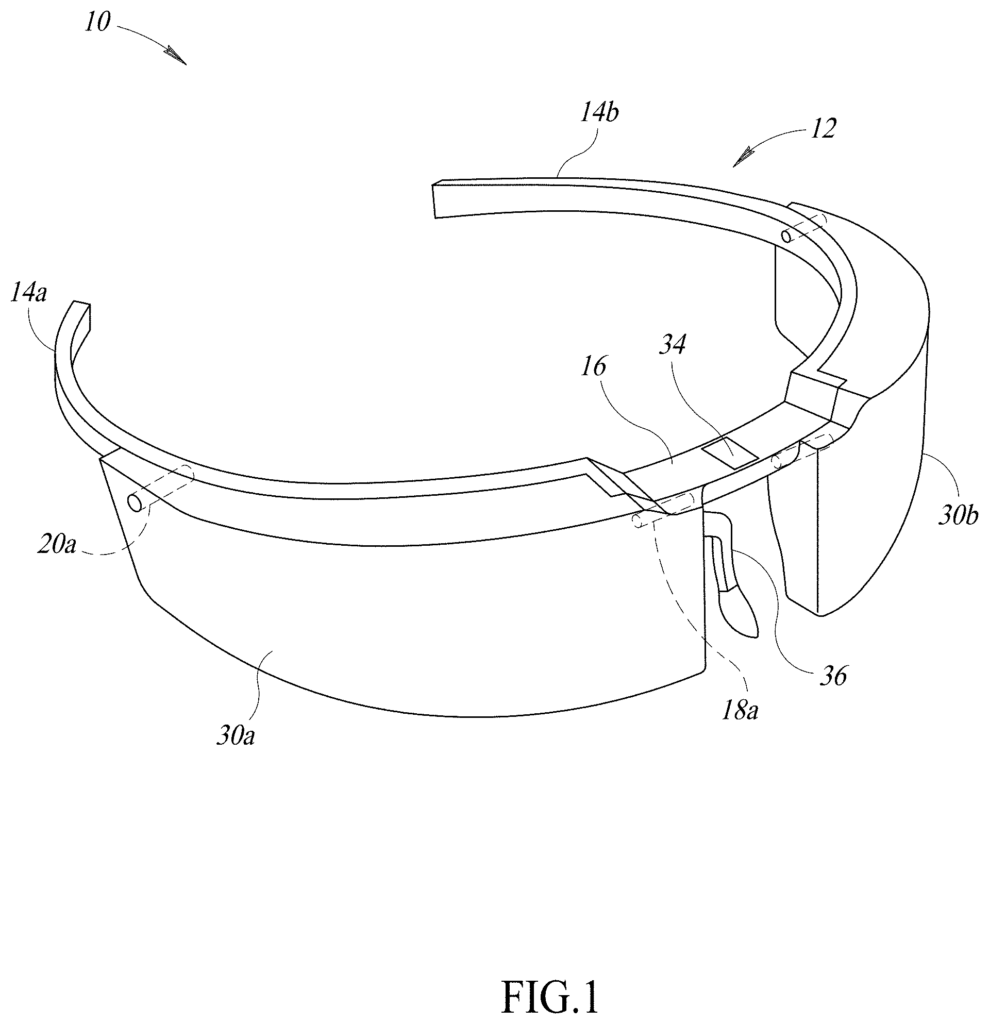
Background for Virtual or Augmented Reality Headsets with adjustable Interpupillary Distance
Technical Field
This disclosure relates generally to virtual reality or augmented-reality headsets and, more specifically, to virtual reality or augmented-reality headsets that allow the interpupillary space between the eyepieces to be adjusted.
Description of Related Art
Virtual or augmented reality headsets are proving to be invaluable in many fields, including medical training, engineering prototyping and design, telemanipulation, telepresence and personal entertainment. Virtual reality systems display computer-generated scenes on a transparent screen. In mixed reality and augmented-reality systems, computer-generated scenes or objects can be combined with views of real-world scenes on a transparent display. Virtual or augmented scenes can be displayed separately on the eyepieces of many virtual reality or augmented-reality headsets. Software can be used to correct for differences in interpupillary spacing between users. The interpupillary space between the optical center of the eyepieces can be mechanically adjusted in some cases. However, such devices may have various disadvantages. The adjustment mechanisms can be too complex, bulky and lack precision. They may also have a limited range.
The embodiments described herein enable virtual or augmented-reality headsets to have robust and efficient forms that allow simultaneous movement of the viewer eyepieces on one or more linear rails in order to adjust interpupillary spacing.
A virtual reality or augmented-reality headset can be described as a frame with a pair virtual reality or augmented-reality eyepieces and an adjustment system coupled to each pair. The frame can include opposing arms, a bridge located between the opposing arms, and a number of linear rails. A central reference plane may define opposing sides to the frame, and at least one linear rail can be provided on each side. The pair of virtual reality or augmented-reality eyepieces may each have an optical centre and be movably connected to the plurality linear rails of frame in order to adjust an interpupillary space between the optical centres. The adjustment mechanism can be used to move the pair virtual or augmented eyepieces simultaneously in alignment with the linear rails. This will adjust the interpupillary space.
The virtual or augmented-reality eyepieces can be moved between a narrowest and widest configuration. A difference in interpupillary space between the widest and narrowest configurations could be as much as 20mm to 24mm.
The adjustment mechanism can be attached to the frame’s bridge and include a manipulable controller coupled to each virtual or enhanced reality eyepiece for selectively adjusting the linear position of all the virtual or enhanced reality eyepieces at the same time. The frame can also include a lock that allows the virtual or enhanced reality eyepieces to be fixed in a specific linear position on the rails.
The adjustment mechanism can include a manipulable actuator that is manually operated by the user. One or more links may physically couple the manipulable actuator to the virtual or enhanced reality eyepieces. The headset can also include a removable cover that can be positioned to either prevent or allow access to manipulable actuators by the user. The manipulable controller may be restricted to translating back and forth perpendicularly to the adjustment direction aligned with the plurality linear rails. Movement of the manipulable controller in one direction can move the virtual reality or augmented-reality eyepieces towards an expanded configuration, while movement in the other direction can move them toward a collapsed arrangement. The manipulable actuator can be accessed by the user even while wearing the headset.
The adjustment mechanism can include one or several linear actuators such as a piezoelectric actuator or motor-driven lead screws.
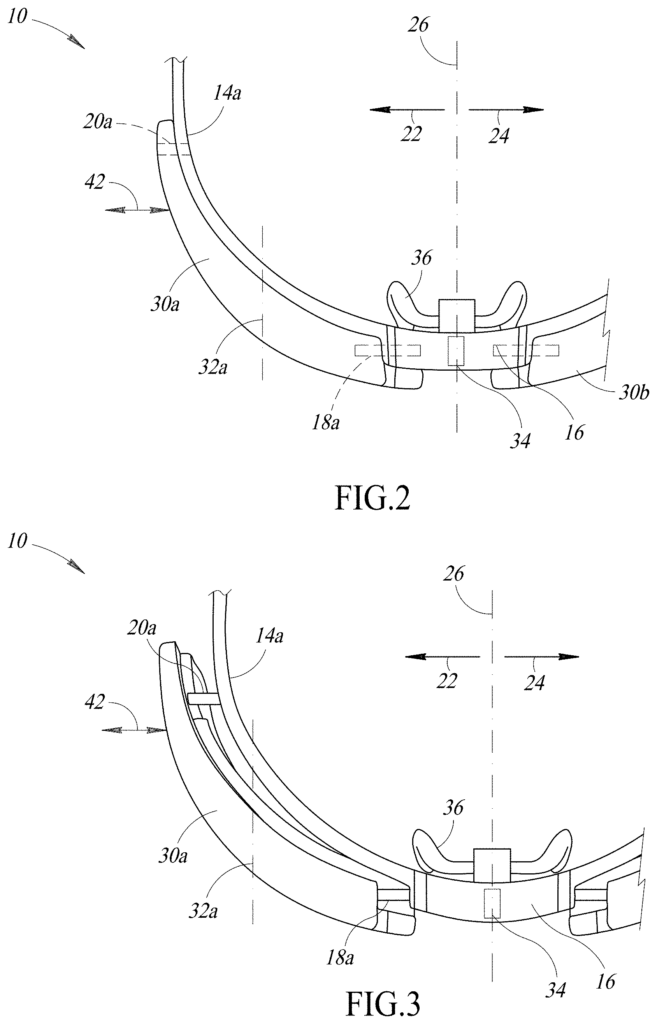
The bridge of the frame can include a nasalpiece that engages the nose of the wearer and supports the virtual or enhanced reality eyepieces directly in front of their eyes. The nosepiece can be removable and coupled to the base portion of the frame to lock the virtual reality or augmented-reality eyepieces into a specific position.
Each virtual or augmented-reality eyepiece can be arcuate, and include both a medial and lateral end. The medial end can be located near the bridge of frame, and the lateral ends can be placed near the temple of one of opposing arm members. The frame can include an arcuate profile at each side of the central plane, to nest at least partially with the respective virtual or enhanced reality eyepiece when they are in their narrowest configuration where the interpupillary space is the smallest. The plurality linear rails can include at least two rails on opposing sides to guide one or more virtual or enhanced reality eyepieces. For each side of frame, the first rail may be located near the bridge and guide the medial or lateral end, while the second rail may be situated near the temple region and guide the lateral or virtual end. The virtual or augmented eyepieces can be connected to two linear rails offset forward and backward from each other.
The plurality of rails can include at least two rails for each side of frame that opposes each other to guide the respective virtual reality or augmented-reality eyepiece. For each of these opposing sides, the rails are located near the bridge so as to guide the medial end of each virtual reality or augmented-reality eyepiece, and to support each virtual reality or augmented-reality eyepiece by a cantilevered method.
The plurality linear rails may include at minimum two linear rails vertically offset on each opposing side of the frame to guide each respective virtual or augmented-reality eyepiece. The at least two rails, along with the arm member, may be arranged to form a fork on each side of the frame. The two linear rails, a portion from the bridge and each opposing side of the frame may form a structure fork that supports one of the virtual reality or augmented-reality eyepieces.
Each of the virtual or enhanced reality eyepieces can be supported by one linear rail. The eyepiece is supported in space by the connection to this single linear rail. In other cases, each virtual or enhanced reality eyepiece may be supported using a single linear rail that is positioned above the horizontal plane defined by optical centers for the pair of eyepieces. The eyepieces are supported in space by only a connection with the single linear rail.
The bridge and the rails may be formed in a single piece. The bridge, opposing arm members, and plurality of rails in the frame can be formed integrally as a single piece.
The frame can also include a central portion of the frame that comprises the bridge. The opposing arm members could be hingedly attached to the central portion.
BRIEF DESCRIPTION ABOUT THE VIEWS FROM THE DRAWINGS
FIG. “FIG.
FIG. “FIG. “Figure 1 in a collapsed position.
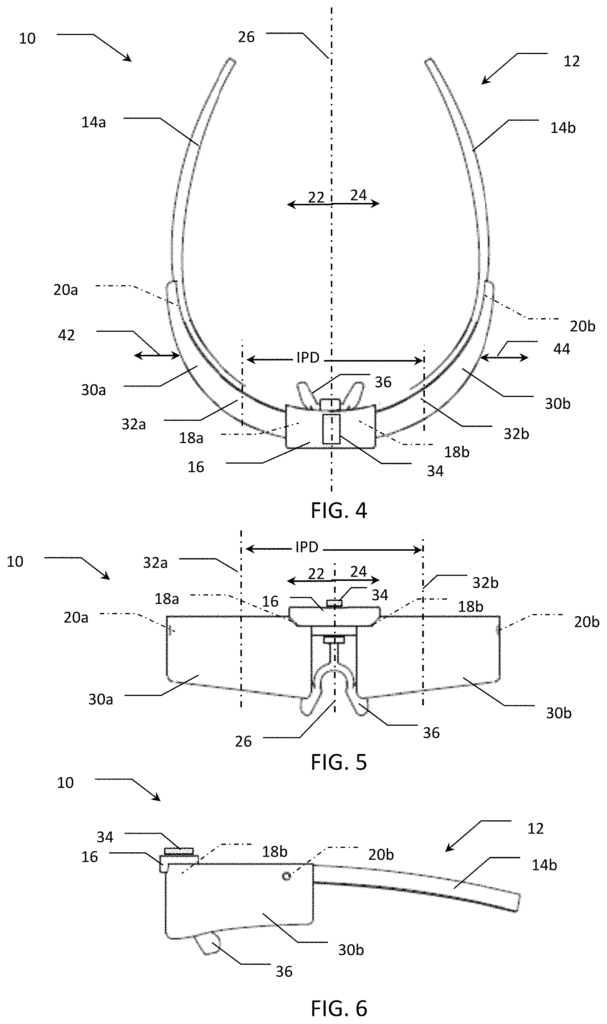
FIG. “FIG. “Figure 1 in a fully expanded configuration.
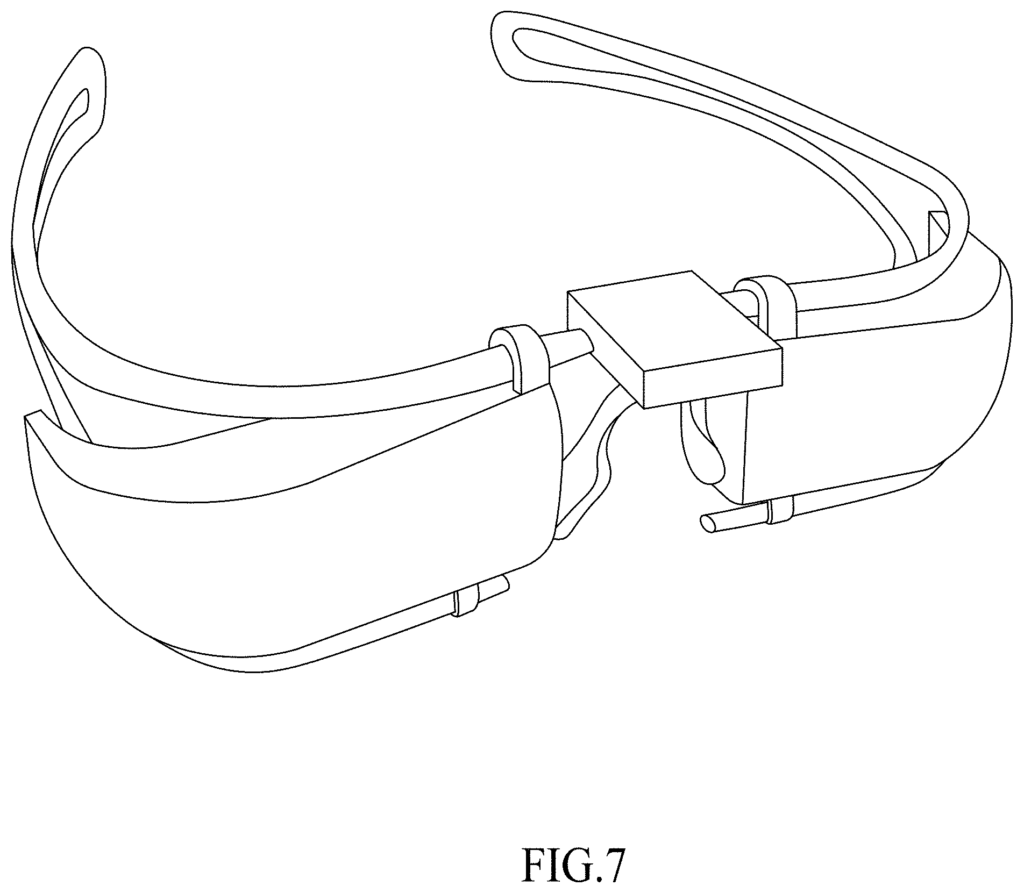
Click here to view the patent on Google Patents.
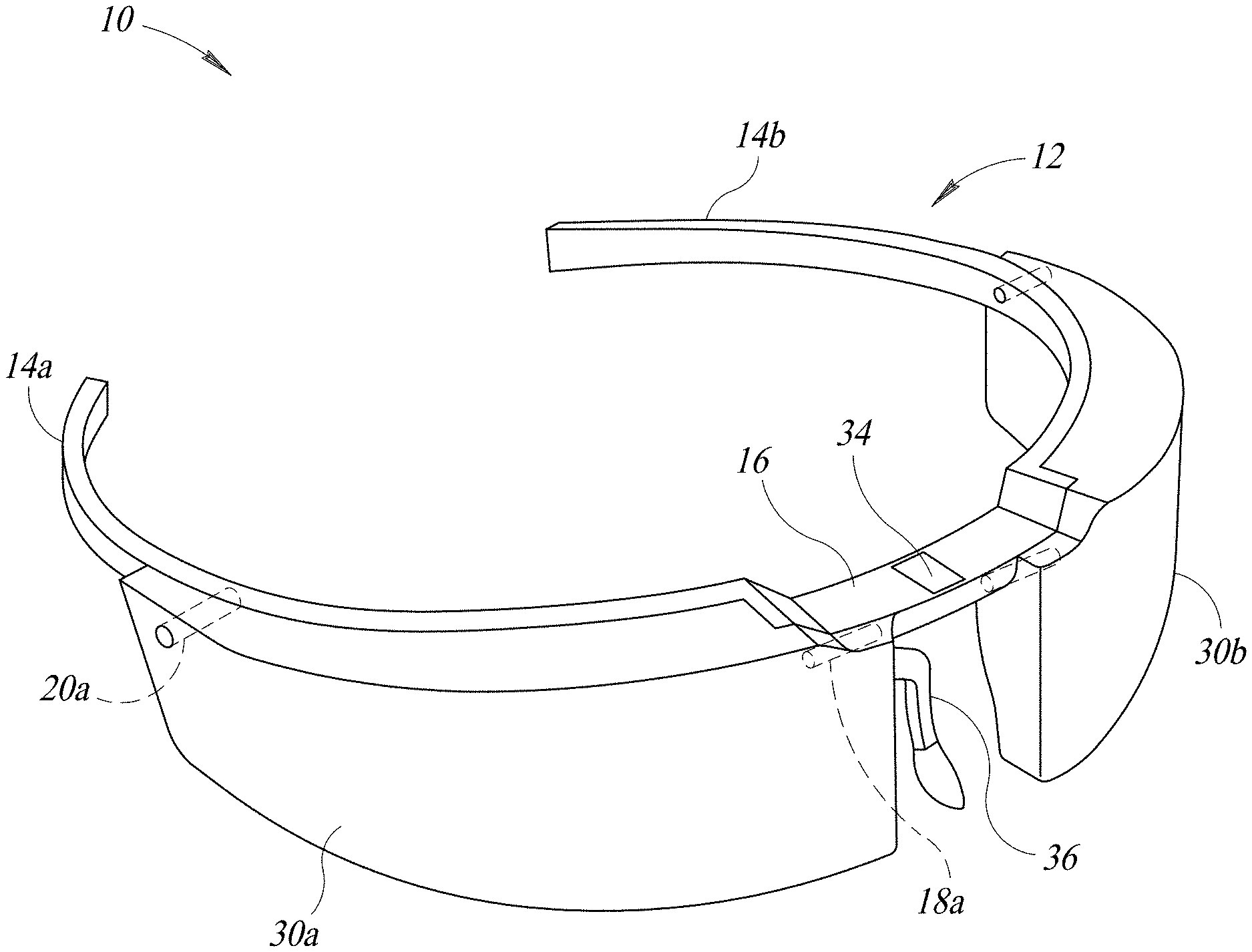
Leave a Reply